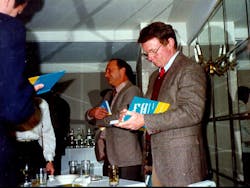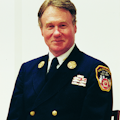I have a confession: I do not know the difference between a simple and compound sentence. Despite that deficit, I have been writing technical articles about firefighting for 35 years. I also must confess the secret to my writing at Firehouse Magazine has been very good editing. I have had great editors in my 35 years with the magazine.
My first editor was a wonderful woman, Elena Sorocki. She always kept telling me, “Vin, write in the first person.” I still do not do that. Elena went on to a successful career at Reader’s Digest Magazine. My next editor, Gloria Sturzenacker, was also terrific, and she made my writing sound like the spoken word. My next editor, Janet Kimmerly, became a lifelong friend. In addition to Firehouse articles, she edited all my books. Janet went on to edit the fire department training magazine WNYF (With New York Firefighters). Now she oversees all magazines, books and pamphlet produced by the FDNY. After Janet, another friend, Jeff Barrington, took over the editing and did a great job. With the new executive editor, Janelle Foskett, I can already tell that we will create many productive Safety & Survival columns.
Writing does not come naturally to me. I was not a born writer. I struggle. For example, in college (with help from the GI Bill), when being handed my first writing exercise paper back for review, the English professor asked me, “Are you here on an athletic scholarship?” Another indicator of my struggle came in 1987 when I was about to compile my book Collapse of Burning Buildings. I had been writing for several years and thought I was getting pretty good. After deciding to write a book, I would write a long Firehouse Magazine article that would serve as a chapter in my book. I saved my original writings on my computer, and when it came time to make the changes from Firehouse articles to my computer writings, I assumed that all I had to do was make a few changes and send a manuscript off to the publisher. Before this I had never compared the published article with my computer manuscripts. But when it came time for this melding of the two, I was shocked. I realized that the editors practically rewritten my articles—and they were much better. I spent hours humbly making the changes and realized what great work editors do. I thank them every chance I get because I now know that they are the reason I have been writing for 35 years—and still do not know the difference between a simple and compound sentence.
So the question is why do I write? Here are three reasons why I have written technical articles about firefighting for 35 years.
First, like a lot of other firefighters responding to fires and emergencies in the 60s and 70s, I witnessed what I considered to be the “sacking, pillaging and burning of New York City”; I was in a state of disbelief of what I was seeing. In 1977, I was assigned to the Bronx where everything was burning (arson fires, vacant building fires, and drug-fueled crazies’ fires)—and it was getting worse. In the firehouse, I kept thinking that something was happening and I didn’t know what, but I better find out. Like Marvin Gaye singing on the radio, I too wanted to know “What’s Going On?” Like a lot of firefighters, I thought it was the end of New York City. I remembered a course in college where we discussed how the written daily logs kept by the bureaucrats throughout the British Empire were valuable to historians. I could do that, I thought. I would document what was happening in the Bronx and New York City during its last days. I would take pictures and write boring technical articles about fires and firefighters, and possibly in 100 years, when historians write about the “firestorm” that was consuming New York City, I might be a reference number.
Secondly, back then I started thinking for the first time in 20 years about what I was doing in my career. I began to ask myself, “What did we just do at that fire?” I asked myself, “Why did this fire spread?” “Why did that firefighter get injured?” “Why did that part of the building collapse?” and other questions. Sometimes I would go back and take photographs. Then, I started writing answers in my articles. Before this I never thought about what I did. I would forget about it, go on with my life, driving kids to school, cutting grass and painting the house. That changed.
The third reason I still write about firefighting is that during past years’ writings, there were topics I mentioned briefly in an article, but could not expand upon because of time or space or a deadline. Today, I still remember these partially mentioned bits of information and now have a chance to expand them into articles. By turning these “leftovers” into magazine articles, I am still taking the advice I give to all firefighters: “Think about what you do.”
About the Author
Vincent Dunn
VINCENT DUNN, a Firehouse® contributing editor, is a 42-year veteran of the FDNY and a deputy chief (ret.), serving as a division commander for midtown Manhattan. He is the author of the best-selling text and DVDs “Collapse of Burning Buildings” and textbooks “Safety and Survival on the Fireground,” “Command and Control of Fires and Emergencies” and “Strategy of Firefighting – How to Extinguish Fires.” His most recent book is titled “Building Construction: The Firefighter’s Battlespace,” and book proceeds will help support the FDNY and FDNY Foundation. Dunn has a master’s degree in urban studies, a bachelor’s degree in sociology and an associate’s degree in fire administration from Queens College, City University of New York.

